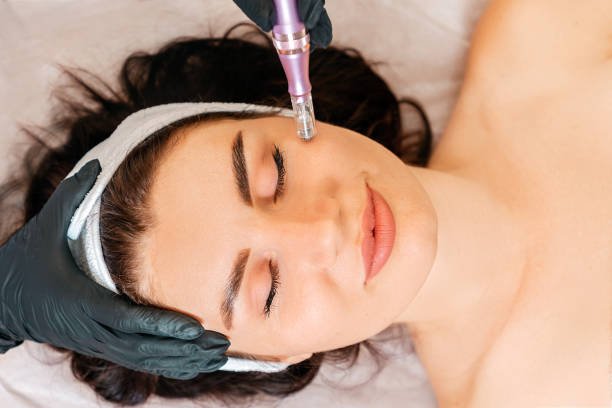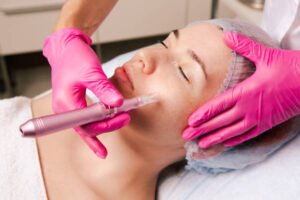
Microneedling Abu Dhabi, also known as collagen induction therapy, is a minimally invasive cosmetic procedure that involves tiny needles to stimulate the skin’s natural healing process. This treatment has gained popularity in recent years for its ability to address various skin concerns, such as acne scars, fine lines, wrinkles, and overall skin texture. In this article, we will explore what microneedling is, how it works, and its benefits for the skin.
What is Microneedling?
Microneedling is a cosmetic treatment that uses a device equipped with fine needles to create tiny, controlled punctures (micro-injuries) in the skin’s surface. These micro-injuries trigger the skin’s natural healing response, encouraging collagen and elastin production. Collagen and elastin are proteins that play a crucial role in maintaining the skin’s structure, firmness, and elasticity. By stimulating the body’s healing mechanisms, microneedling helps to improve the appearance of the skin over time.
Microneedling is often performed using a device called a dermaroller or a motorized dermapen. The treatment is typically done on the face, but it can also be used on other areas of the body, such as the neck, chest, and hands, to address skin concerns like stretch marks and scars.

How Does Microneedling Work?
The process of microneedling is relatively simple and straightforward. Here’s a step-by-step breakdown of how the treatment works:
- Consultation: Before the procedure, you will have a consultation with a dermatologist or licensed aesthetician to discuss your skin concerns and determine if microneedling is the right option for you. Your medical history and skin condition will be evaluated.
- Preparation: On the day of the procedure, the treatment area will be thoroughly cleansed to remove any makeup, dirt, or oils. A topical numbing cream is usually applied to the skin to minimize discomfort during the procedure.
- Needling Process: After the numbing cream has taken effect, the microneedling device is gently rolled or stamped over the skin. The device contains tiny, fine needles that penetrate the outer layer of the skin (epidermis) and reach the dermis, the deeper layer of skin. The depth of the needles varies depending on the type of skin concern being treated.
- Healing Response: The controlled micro-injuries stimulate the body’s natural healing process. The skin begins to produce collagen and elastin to repair the punctures, resulting in firmer, smoother skin.
- Post-Treatment Care: After the procedure, the skin may appear red or slightly inflamed, similar to a mild sunburn. This is a normal reaction and typically subsides within a few hours to a couple of days. Your dermatologist may recommend a gentle skincare routine to promote healing and avoid irritation.
Benefits of Microneedling
Microneedling offers numerous benefits for the skin. Some of the most notable advantages include:
- Improved Skin Texture and Tone: By stimulating collagen production, microneedling can improve the texture and tone of the skin, making it smoother and more even.
- Reduction of Fine Lines and Wrinkles: The increased collagen production can help diminish the appearance of fine lines and wrinkles, especially around the eyes, mouth, and forehead.
- Treatment for Acne Scars: Microneedling is effective in reducing the appearance of acne scars, especially atrophic (depressed) scars. The procedure promotes the regeneration of healthy skin, helping to smooth out scar tissue.
- Minimizing Pore Size: The treatment can also help reduce the size of enlarged pores by encouraging collagen formation around the pores, leading to a smoother surface.
- Improved Absorption of Skincare Products: After microneedling, the skin’s permeability increases, allowing topical skincare products (such as serums and moisturizers) to penetrate more effectively and work better.
- Safe for All Skin Types: Microneedling is generally safe for all skin types and tones. It does not cause pigmentation changes, which can sometimes be a concern with other treatments like chemical peels or laser resurfacing.
What Skin Concerns Can Microneedling Address?
Microneedling can treat a wide range of skin concerns, making it a versatile procedure. Some of the common conditions that microneedling can address include:
- Acne Scars: Microneedling is particularly effective for treating acne scars, especially shallow scars. The treatment stimulates collagen production, which helps repair damaged skin tissue.
- Fine Lines and Wrinkles: By boosting collagen and elastin, microneedling can reduce the appearance of fine lines and wrinkles, especially around the eyes, mouth, and forehead.
- Hyperpigmentation: The procedure can help fade dark spots and uneven skin tone caused by sun damage, melasma, or post-inflammatory hyperpigmentation.
- Stretch Marks: Microneedling can improve the appearance of stretch marks by stimulating collagen production in the affected areas.
- Enlarged Pores: As the skin becomes firmer and more even, microneedling can help minimize the appearance of enlarged pores.
- General Skin Rejuvenation: For individuals with dull or lackluster skin, microneedling can revitalize the complexion by encouraging the production of new, healthy skin cells.
Microneedling vs. Other Treatments
Microneedling is often compared to other skin rejuvenation treatments, such as chemical peels, laser resurfacing, and dermabrasion. While these treatments can also improve skin texture and tone, microneedling has distinct advantages:
- Minimally Invasive: Unlike laser treatments, microneedling doesn’t involve the use of heat or intense light, making it a gentler option with fewer risks and side effects.
- Faster Recovery: Compared to procedures like laser resurfacing, microneedling typically has a quicker recovery time. Most people experience only mild redness and irritation for a day or two.
- Suitable for All Skin Types: Microneedling is safe for all skin tones and types, whereas some laser treatments can cause pigmentation issues in individuals with darker skin.
- Cost-Effective: Microneedling tends to be more affordable compared to other skin resurfacing treatments, making it accessible for a wider range of individuals.
Risks and Side Effects of Microneedling
While microneedling is generally safe, there are some potential risks and side effects to consider. These include:
- Redness and Swelling: It’s normal to experience redness and slight swelling after the procedure, which typically subsides within a few hours to a couple of days.
- Skin Sensitivity: Your skin may feel sensitive to the touch for a few days following the treatment.
- Infection: Although rare, there is a risk of infection if the microneedling device is not properly sanitized or if aftercare instructions are not followed.
- Hyperpigmentation or Hypopigmentation: In some cases, microneedling can lead to temporary darkening (hyperpigmentation) or lightening (hypopigmentation) of the skin, especially if the skin is not properly protected from the sun.
Conclusion
Microneedling is a safe, effective, and minimally invasive treatment that offers a wide range of benefits for improving skin texture, reducing scars, and addressing fine lines and wrinkles. By stimulating collagen production, microneedling enhances the skin’s natural healing process, resulting in smoother, more youthful-looking skin. While the procedure carries minimal risks, it’s essential to consult with a professional to determine if microneedling is the right choice for your skin concerns.



